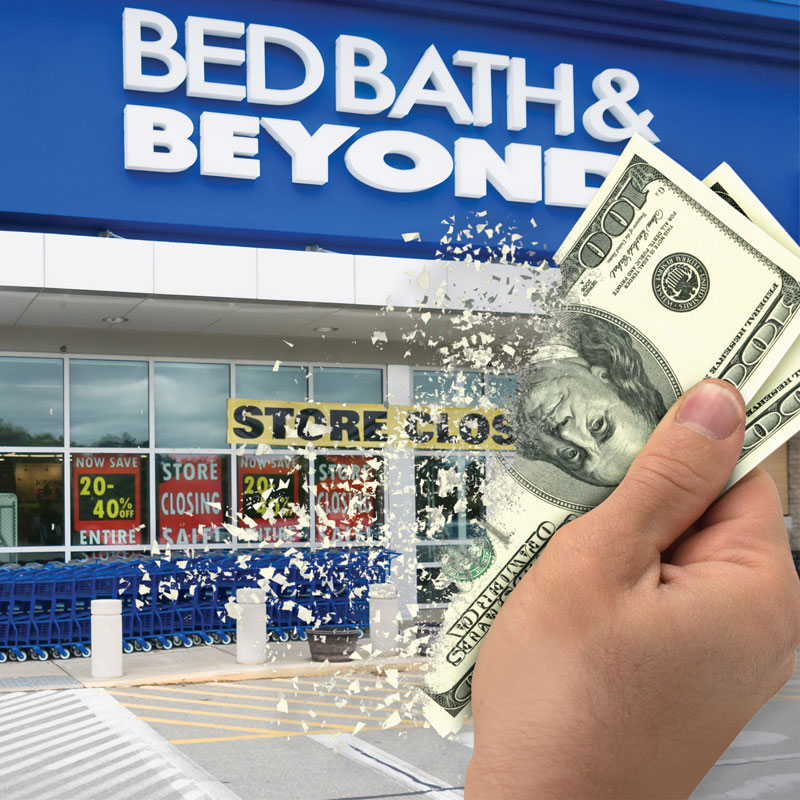As recently as just a few years ago, Bed Bath & Beyond did over $5 billion in annual retail sales. Tuesday Morning was doing close to $700 million a year before it closed. Christmas Tree Shops, privately owned before it also announced its closing, had a yearly estimated revenue of about the same level, $700 million. Throw in the home furnishings sales of a few other chains that have gone belly-up like David’s Bridal, Party City and Sears Hometown and you can add in another $100 or $200 million in sales, easy.
It’s the suppliers who are in the biggest mess. Big vendors to BBB might have done $100 million – some even more – a year with that single account.
Put it all together and that’s close to $7 billion in annual home furnishings revenue generated by stores that have been liquidated – or are in the process of being liquidated. And most of it has disappeared forever.
Because of more careful monitoring of accounts receivable throughout the ordering process, the money due to creditors from these bankruptcies rarely stretched into seven figures, much less eight. So, vendors did not get stung as badly as they had historically been tagged by previous retail bankruptcies.
But the bigger problem is the loss of annual top-line business with the closing of all these retail chains. Using the good old keystone equation of wholesale being about half of retail – an imprecise measurement to be sure but the best we’ve got – home furnishings vendors are looking at a shortfall of at least $3.5 billion in yearly sales.
And history would suggest that most of it will evaporate, never to be seen again.
The Law of Migrating Retail Sales
Consumer purchasing patterns are a funny thing. As often as people say they plan their buying and keep tight budgets on what they will spend, it rarely works out that way. The fact of the matter is that retailers are really good at driving business through advertising, sales, promotions, coupons and just being in plain sight as people drive to work or do errands. That big bad Bed Bath & Beyond coupon that arrived like clockwork every few weeks in American mailboxes was an amazing vehicle to get people to go to their local store and spend, often far more than they ever planned. BBB didn’t get to be so successful — $11 billion in annual sales at its peak in the 2010s – by sitting around and waiting for customers to show up.
Without all this promotional and marketing activity so much of this business simply disappears. Without that coupon, that one-day sale, that act-before-midnight-tonight blaring TV commercial, shopping loses its place as top of mind, replaced by Netflix, Uber Eats and a day at the beach.
This is especially true when it comes to home furnishings. Unlike absolutely necessary purchases like food and drugs or more aspirational buying for things such as new clothing and shoes, very few people really need a new set of towels, more cookware or dishes…or even bigger ticket items like rugs, furniture and mattresses. We may have a need to replace some of these – and most sales for home furnishings these days are replacement sales – but we can certainly wait a week, a month or even longer to do that. The fact that so few home furnishings brands drive sales themselves through advertising or marketing only adds to the perception that since those former behemoth retail brands are no longer promoting, it feels like nobody is promoting.
Ephemeral Retail
And if it seems like nobody is promoting, nobody is going to be selling. So, with Bed Bath or Tuesday Morning or the others no longer showing up on social media, email feeds or with coupons and circulars in mailboxes, that business simply isn’t happening anywhere else. This is not some theory, either. When Linens’n Things – BBB’s one-time closest competitor – went out of business in 2008 it was doing just shy of $3 billion a year in sales. But how much of that $3 billion migrated back to competitors like Bed Bath, Macy’s, Kohl’s, Target, TJX and that emerging thing called the internet? Looking at the top-line growth of those brands from that era and you’ll see small incremental gains but nothing like a cumulative $3 billion. If it was half of that, it was a lot.
This is not an isolated example. When JCPenney lost 25 percent of its revenues in just the first 12 months of the ill-fated Ron Johnson era, one would think a big chunk of that $4.3 billion in business would have gone across the highway to its closest competitor, Kohl’s. Nothing of the sort happened. Some of that revenue did trickle to Kohl’s, for sure, and some went to the other end of the mall to Macy’s but most of it just went up in a giant puff of smoke.
When Bon-Ton closed all of its 200 stores in 2018, other department stores – often in the same shopping center appealing to the same demographic – didn’t see much of a spike in their business. And the saddest example of business simply evaporating? It’s Sears of course, which at its peak had annual sales of over $16 billion. Yes, that includes Kmart, but even taking that out of the equation, that’s a lot of revenue from power tools, car batteries and washing machines. As it was disintegrating over the past two decades, some of that business went to competitors like Home Depot and Lowe’s and some to specialty chains like Auto Zone and Tractor Supply Co. But a lot of it simply went away.
Vexed Vendors
So, back to the present and this latest wave of retail elimination. It’s not like shoppers will have any shortage of places to buy stuff. Between strong national chains, ecommerce and direct-to-consumer sellers, there remain plenty of choices and nobody is going to be denied new percale sheets.
It’s the suppliers who are in the biggest mess. Big vendors to BBB might have done $100 million – some even more – a year with that single account. Even with Overstock’s takeover of the brand, it is not going to absorb anywhere near that amount of business. For suppliers of soft home, kitchenware, housewares, and the thousands of products that BBB crammed into its stores – and similar assortments at Tuesday Morning and Christmas Tree – there is simply no place to go to replace that amount of business.
Since most of these products are made offshore, we’re not talking about American factories closing and workers being laid off. There are unintended consequences to the supply chain ecosystem. The residual side effects will be widespread: Connect the dots and workers at ports handling less cargo, truckers hauling fewer loads to stores, and delivery services bringing online packages to homes.
The suppliers themselves will have to get smaller, leaner, and more aggressive — getting new business wherever they can. Many are likely to go out of business since their margins and cash reserves were not that great, to begin with.
That $7 billion decline in retail business – OK, call it $4 billion after some of it is absorbed by other retailers – only tells part of the story of 2023. The second wave will be all the home product suppliers who won’t make it through the year. America most certainly has a homeless crisis of graver consequences for our society overall, but for the home furnishings business, its latest crisis is just beginning.




